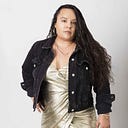This will just be a quick note for everyone who feels teh same way Sabrina Jordan has.
DNA tests don’t determine the number of ancestors you had from each region of the world. Siblings who share both parents can have very different results, simply because of the LITERAL dance that DNA does in our eggs and sperm cells.
Sabrina’s results showed 39% European while her sister’s results showed closer to 33%. That’s pretty accurate and a reasonable difference for siblings.
But as she said…
This does not lead her closer to “whiteness.”
The concepts of “black” and “white” were created in the Americas; these 2 specific terms, literally in the US itself. In most of Central and South America, there are different “labels” used to signify skin tone and ancestral heritage.
“Black and White” became popular in the US, because of THREE very specific reasons.
FIRST- the One Drop Rule
the “one drop rule.” For those who don’t know, this means “one drop” of African blood, and you’re black. More precisely, if 1 of your 32 great-great-great grandparents was African, you were considered black, and in almost all states, it was illegal for a black person and white person to marry.
The goal of this was to keep wealth and opportunity centralized within the white community and to discourage younger white people from pursuing relationships with nonwhite people.
SECOND — loss of connection to African and European homelands
It’s no surprise that African descendants often loss access to information about their ancestor’s homelands, since the Europeans went through great lengths to strip away any cultural connection to the past.
Certain areas however, remained resistant to such intrusion, especially the Gullah Geechee of the Carolinas and groups around New Orleans.
But this loss of connection was also felt by Europeans. After 100 or 200 years, European groups started to mix and mingle, losing their ties to one specific European homeland.
THIRD-Good ol fashioned patriotism
I hope you detected the sarcasm. Before White America demanded that Melanated groups abandon their respect for ancestors, they started it within their own ranks.
The identity of “whiteness” was a way to unify all Europeans, regardless of where their ancestor immigrated from.
When Roosevelt declared there should be no “hyphenated” Americans, he wasn’t speaking of melanated groups. He was talking about Europeans.
For much of US history, there were large groups of Africans and Europeans, with small pockets of people from Southeast Asia, and outside of the Southwest US, sparsely dispersed Latinx communities, mostly near larger cities.
This is why most government documents to this day have very limited options for ancestral or heritage identification:
black, white, asian, indigenous/native/pacific islander and then a little “ethnic” tag for hispanic
Essentially reducing great diversity of experiences and cultures into 4.5 categories for their ease of “consumption” and “organization.”
What’s a LatinX or Arabic or someone of African or Indigenous ancestry to do if their way of life is not reflected by such broad categories?
That’s what the Brits call “the rub.”
We still aint figured that one out.
I mean think about it. While a Yoruba descendant of West Africa may have no issue being called “black” in the US, there is a firm understanding that his/her experience and cultural heritage are far different from a Brazillian, Colombian or US citizen with the same skin tone.
These 4 people do not speak the same first language. Their home, school, and social experiences were drastically different. Their physical and mental health concerns do not overlap in many cases, though there may be some connection here.
When it comes to Arabic people and people indigenous to various islands, it is even more challenging.
Within each of these groups, there is a wide array of skin tones, facial features, and hair textures. Your typical American would not understand how dark skin and light skin people could exist within the same identity and feel no division or difference between them,
When asked, “What are you?” most will identify with their specific country or island of origin, or they may identify with a specific family group. These are people with long and deep roots, whose connection to their history has NEVER been severed. To tell them to identify as black or white or other is absurd or even offensive at times.
How do they relate to Sabrina Jordan’s story?
Because Arabic people often have a mixture of DNA that is not firmly assignable to one specific region. There is a mixture of African, West Asian and South Asian.
And both Arabic and Island natives have a strong connection to their ancestors, their struggle, their power, and their future.
What’s different though is their proximity to whiteness?
Many Latinx people realize they likely have a mixture of African, Indigenous and European ancestry, while most Arabic people do not, and only some of the Island natives do.
So when those DNA test results come in, there is a mixture, minus the European, and with that comes the question…
So Are you black or not?
I have no answer. Because if the options in the US are “black, white, asian, pacific islander/indigenous” and a tag for “hispanic” are you any of these? Because when they added Asian, they only meant Southeast Asian.
What do you think?
Drop a comment or reply with your thoughts.
